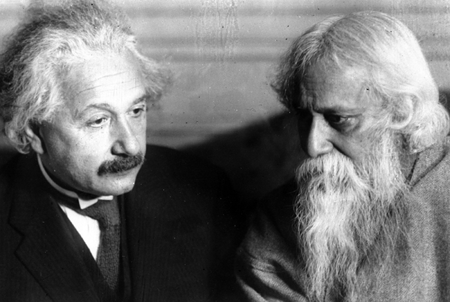|
"A blockchain is a distributed ledger database
that maintains a continuously-growing list of transactions in the form
of ordered records called blocks."
-Wikipedia
"If you can't explain it to a 10 year old, you
don't know it yourself"
– Albert Einstein (attributed, but disputed)
Clearly, not a lot of people without a substantial
background in technology can make much sense from the Wikipedia definition
of blockchains.
Any technologist who wants to explain the
concept to a business leader or an investor who isn't very tech savvy
would require a simplified version.
With a nod to Einstein, who supposedly and
inadvertently created a framework for such simplification, this is best
done by way of a story as below:

Did I say that? Talking it over—Professor
Albert Einstein, author of the Theory of Relativity, calls upon
Rabindranath Tagore, right, noted Indian poet and philosopher, in
New York, December 15, 1930. |
Let’s
Go For Ice Cream
Andrew runs an ice-cream shop in a small
town. Bob, who has a hot dog cart, has just deposited all his earnings
of the day into the bank and is on his way back home.
He looks longingly at the ice cream cart,
well knowing he has no money left in his pocket.
Andrew notices this, and offers him an ice
cream on credit. Bob offers him two hot dogs in return but Andrew declines,
because he doesn't eat meat.
Never on
Sundae
“This sundae is the last one I have.
If you take it, I can close up and go home. Just pay me tomorrow,”
he tells Bob with a smile and notes down the transaction in his little
account book.
Bob gratefully accepts the ice cream and
digs into it.
He too makes a note in his own account book
that he owes Andrew a sum of $8 for the ice cream sundae and sits down
on a bench by the road to enjoy the ice-cream.
Put Up Or
Shut Up
The ice-cream shop is about to close for
the day, when Charlie the milkman rushes in, and demands his week's invoice
of $100 for milk be settled immediately.
Andrew hands over $92, which was all the
cash he had on him.
Charlie shakes his head, "Andrew, I
need the $8 now.
“This $92 goes straight to my creditors
and that leaves me only that $8 for getting something to eat."
Hot Dog An Answer!
Charlie then turns to Bob and points at
his hot dog cart.
You got any hot dogs left? I'm starving!"
Bob jumps up in glee, "Oh yes. Shall
I give you two? That'll be $8 please." Charlie shakes his head again,
"Sorry, I don't have any money left.
“This cash goes straight to my creditor
who is waiting across the road.
“But they do look delicious!"
Bob quickly runs over to Charlie and hands
him the two hot dogs, before explaining “That's fine. I owe Andrew
$8, which is exactly what he owes you, and what you need to pay for these
two hot dogs.
“Enjoy!”
Andrew and Bob both fish out their notebooks.
Bob strikes off the record of buying the
ice cream sundae, while Andrew is more disciplined – he writes "Received"
neatly, in small letters next to his record of making that sale on credit.
Charlie was busy digging into his hot dog
to notice all this.
With a full stomach and a handful of cash,
he darts back across the road to settle his other debt with his creditor.
How Blockchain
Works
The above story is about transactions in
a mini-economy of three people (if you don't include the creditor, who
never actually makes an appearance) in a small ice cream shop.
Since Bob was there at the right time when
the transaction between Andrew and Charlie took place, he was able to
help them settle it effectively without any delay.
Otherwise, the only record for their transaction
was their private notebook entries, and Charlie would never be aware of
their business relationship.
Not one, but three transactions would have
ended up going unsettled on that day. Instead, on this occasion, all three
debts were settled quickly without any cash changing hands.
The Big Picture
Now imagine if instead of just three people
and three transactions, this was a series of one hundred thousand transactions
between twenty thousand people.
That would take a lot of coincidences to
be settled on the fly, especially if there wasn't enough hard cash to
be spread around.
And a handful of notebooks (ledgers) wouldn't
be sufficient.
What that situation would have demanded
is one huge ledger to record all those transactions; it would have to
be secure, easily accessible and dynamically updated to ensure it is continually
accurate.
After all, in such a large economy we cannot
assume that everyone trusts each other!
This is where the blockchain comes in.
At its simplest, blockchain is a distributed
ledger that records transactions in the form of blocks, so arranged and
linked to each other in such a way that no modification or reordering
is possible.
The adjective 'distributed' signifies that
this ledger is not stored in a single place – instead, once a record
originates somewhere, as it did in Andrew's notebook, it is immediately
replicated everywhere on the network so as to inform everyone concerned
that this transaction took place.
Even if Bob wasn't present to tell Charlie
about his own debt to Andrew, Charlie could have found out about it if
it was recorded on a blockchain.
Safe &
Sound Deals
A transaction once entered on a blockchain
cannot be deleted or modified – which is akin to saying Andrew can
never strike off the debt from his book.
He can, however, add another transaction
that pays off the debt, thus maintaining a zero balance.
Blockchain history is never erased, especially
because it is already replicated and presented to all other participants
on the network.
At the same time, since each and every transaction
becomes a record on the blockchain, there is no danger of any party trying
to collect on a debt more than once by exploiting lack of information.
If Andrew had paid off Charlie's debt immediately,
then Bob would know instantly, thus preventing any fraudulent attempt
by Charlie to get paid twice!
Blockchain
Bitcoin
While they have been in existence for a
couple of decades or more now, blockchains gained popularity in recent
times with the advent of Bitcoin, the virtual currency that can actually
be used in real world business transactions such as buying and selling.
Partly on account of this history, most people still consider blockchains
to be an underlying technology for banking and finance in the modern age.
However, as different industries, and air
cargo recognize the potential of bitcoin in their business, new and more
practical use applications are emerging.
It is undoubtedly one of the buzzwords of
the decade, and possibly the innovation of the century – so pay
attention to the Blockchain!
Ashok Rajan, Global Business Head, Airline
Cargo Services, IBS
|




 Vol.
18 No. 7
Vol.
18 No. 7